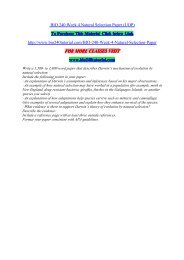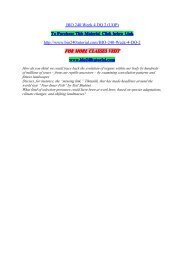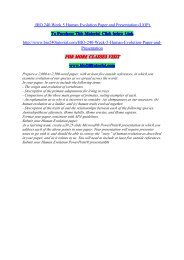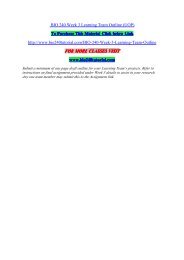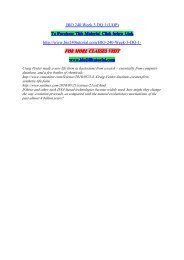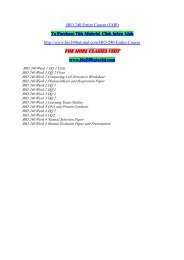BIO 240 Week 3 DNA and Protein Synthesis (UOP)./ uophelp
FOR MORE CLASSES VISIT www.bio240tutorial.com Answer the following questions, in a total of 500 to 700 words. - Describe the structure of DNA and the steps of protein synthesis. - Describe the relationships between the following terms: - DNA - Chromatin material - Gene - Chromosome - Use the following gene in protein synthesis: TAGGACCATTTTAGCCCC - Show the mRNA. - Show the tRNA. - Name the amino acids that will be placed in the polypeptide chain. (Use the codon table in Ch. 17 of Campbell Biology.) - A gene will direct the making of polypeptide chains, and polypeptide chains form proteins. All enzymes are proteins. Therefore, how would you explain carrying a gene for a trait that does not show up in the offspring? - In order for DNA to pass genetic information to the next generation, DNA must replicate successfully. Mistakes in replication could result in major problems in heredity. - Explain how DNA replicates. - Describe the formation of the leading strand and lagging strand and include the enzymes involved. Why do the legs replicate differently?
FOR MORE CLASSES VISIT
www.bio240tutorial.com
Answer the following questions, in a total of 500 to 700 words.
- Describe the structure of DNA and the steps of protein synthesis.
- Describe the relationships between the following terms:
- DNA
- Chromatin material
- Gene
- Chromosome
- Use the following gene in protein synthesis:
TAGGACCATTTTAGCCCC
- Show the mRNA.
- Show the tRNA.
- Name the amino acids that will be placed in the polypeptide chain. (Use the codon table in Ch. 17 of Campbell Biology.)
- A gene will direct the making of polypeptide chains, and polypeptide chains form proteins. All enzymes are proteins. Therefore, how would you explain carrying a gene for a trait that does not show up in the offspring?
- In order for DNA to pass genetic information to the next generation, DNA must replicate successfully. Mistakes in replication could result in major problems in heredity.
- Explain how DNA replicates.
- Describe the formation of the leading strand and lagging strand and include the enzymes involved.
Why do the legs replicate differently?
You also want an ePaper? Increase the reach of your titles
YUMPU automatically turns print PDFs into web optimized ePapers that Google loves.
<strong>BIO</strong> <strong>240</strong> <strong>Week</strong> 3 <strong>DNA</strong> <strong>and</strong> <strong>Protein</strong> <strong>Synthesis</strong> (<strong>UOP</strong>)To Purchase This Material Click below Linkhttp://www.bio<strong>240</strong>tutorial.com/<strong>BIO</strong>-<strong>240</strong>-<strong>Week</strong>-3-<strong>DNA</strong>-<strong>and</strong>-<strong>Protein</strong>-<strong>Synthesis</strong>FOR MORE CLASSES VISITwww.bio<strong>240</strong>tutorial.comAnswer the following questions, in a total of 500 to 700 words.- Describe the structure of <strong>DNA</strong> <strong>and</strong> the steps of protein synthesis.- Describe the relationships between the following terms:- <strong>DNA</strong>- Chromatin material- Gene- Chromosome- Use the following gene in protein synthesis:TAGGACCATTTTAGCCCC- Show the mRNA.- Show the tRNA.- Name the amino acids that will be placed in the polypeptide chain. (Use the codon table inCh. 17 of Campbell Biology.)- A gene will direct the making of polypeptide chains, <strong>and</strong> polypeptide chains form proteins.All enzymes are proteins. Therefore, how would you explain carrying a gene for a trait thatdoes not show up in the offspring?- In order for <strong>DNA</strong> to pass genetic information to the next generation, <strong>DNA</strong> must replicatesuccessfully. Mistakes in replication could result in major problems in heredity.- Explain how <strong>DNA</strong> replicates.- Describe the formation of the leading str<strong>and</strong> <strong>and</strong> lagging str<strong>and</strong> <strong>and</strong> include the enzymesinvolved.Why do the legs replicate differently?



